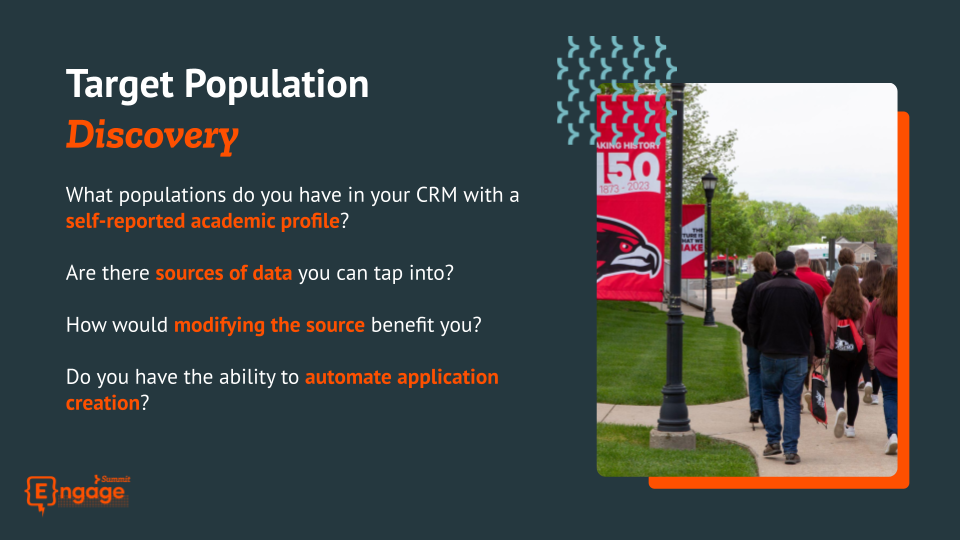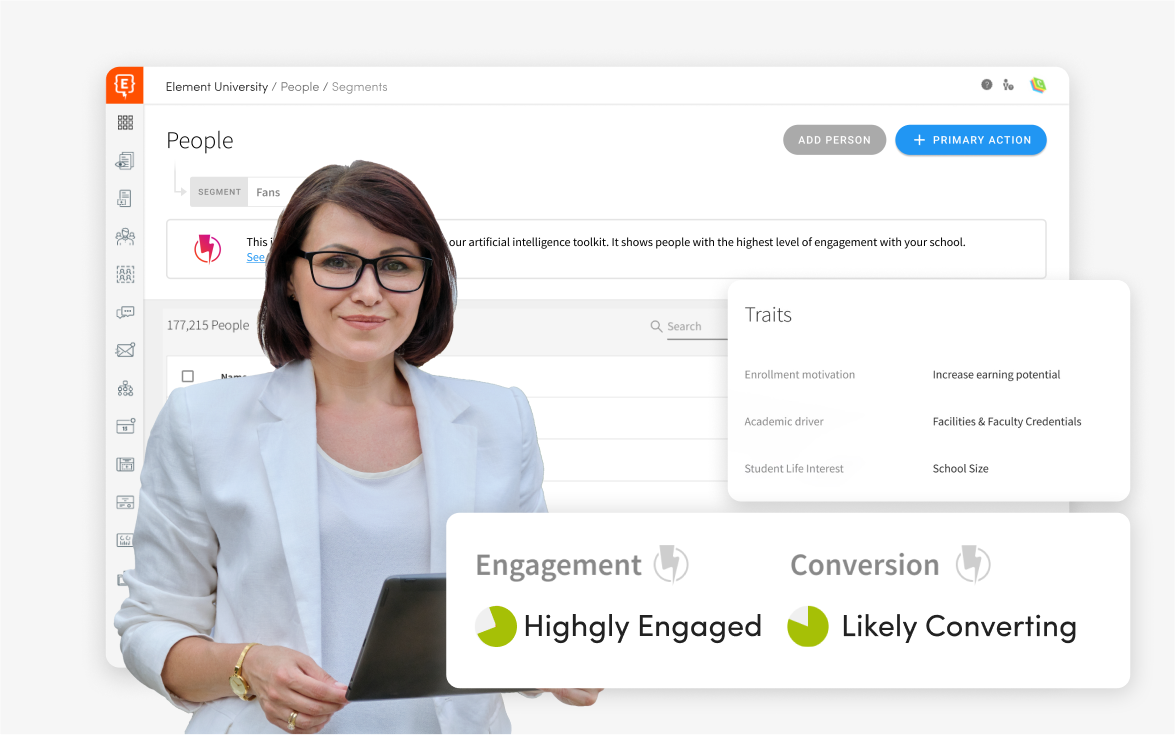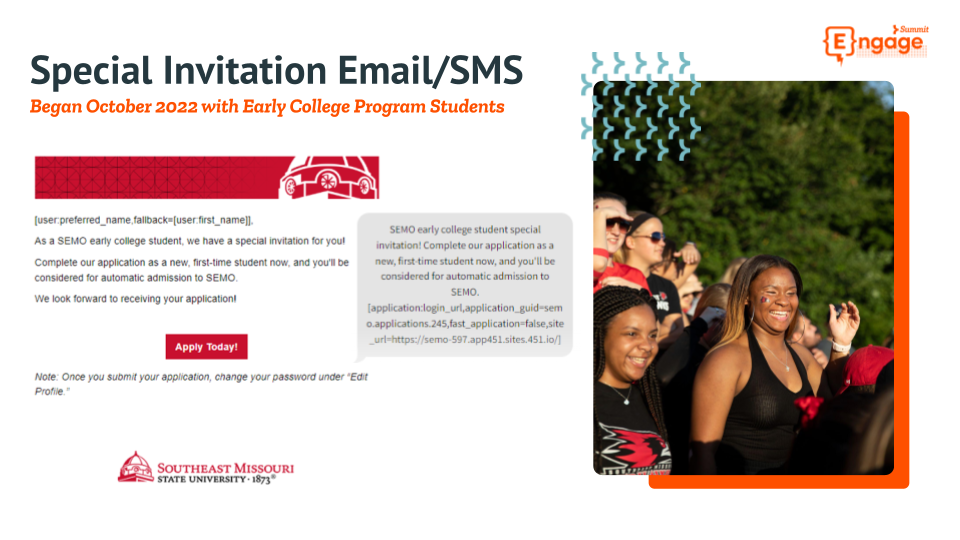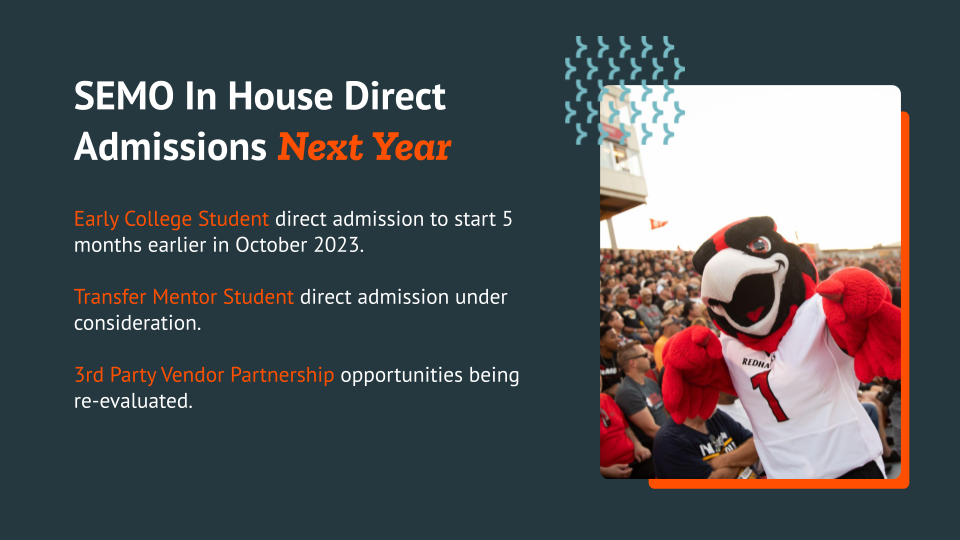How to Automate In-House Direct Admissions: A Step-by-Step Guide
by Sirley Carballo · Updated Sep 13, 2024

Implementing an automated in-house direct admissions process can significantly streamline and expedite the enrollment process for institutions. In this guide, we will outline a step-by-step process based on Southeast Missouri State University's (SEMO) successful implementation.
By following these steps, your institution can efficiently automate direct admissions, reduce friction for prospective students, and increase enrollment outcomes.
What is Direct Admissions?
Direct admissions is a process in which high school seniors are offered acceptance by a particular college or university without applying — bypassing the traditional and often lengthy admission process.
This process is becoming more popular among colleges and universities, as it offers a more efficient and streamlined admission process for students.
Direct admission pilot programs are showing early signs of improved enrollment rates by increasing the number of students participating colleges admit.
Due to its ease for students and quick turnaround, there are many benefits to direct admissions for colleges and institutions that have felt the effects of recent enrollment trends. They include:
- Providing underrepresented students with higher education opportunities
- Bridging the enrollment gap created by decreasing high school graduation rates
- Reaching high-priority students more quickly
Instead of waiting for students to apply to their schools, admissions teams can now extend enrollment offers to way more prospects than ever before.
Schools like SEMO that are already implementing this process hope that by increasing the number of prospects at the very top of the funnel, they can yield larger classes than in recent years.
Step-by-Step Guide to Automating In-House Direct Admissions
Drawing valuable insights from the path carved by our partners at SEMO, we will share practical strategies and techniques that you can implement to transform your admissions process.
Let’s dive into the SEMO experience and explore the tools you need and steps you should take to successfully automate your own direct admissions program.
Step 1: Assess the Current Enrollment Process and Identify Pain Points
(1-year to 9 months prior to implementation)
The first step of automating an in-house direct admissions process is evaluating your existing system for improvement and identifying any pain points.
The SEMO team took a proactive approach to evaluate their admissions process and identify areas that could be automated to improve efficiency. They recognized the value of gathering feedback from admissions staff, counselors, and prospective students to truly understand the pain points and areas for improvement within the admissions process.
This thorough evaluation allowed SEMO to set realistic goals and make data-driven decisions to enhance the overall experience for both students and staff.
Next steps:
- Evaluate the existing admissions process and identify areas that can be automated to improve efficiency.
- Gather feedback from admissions staff, counselors, and prospective students to understand pain points and areas for improvement.

Step 2: Choose a Robust CRM Platform Made for Higher Education
(6-9 months prior to implementation)
By investing in a reliable CRM platform, schools looking to establish their own in-house direct admissions process can streamline their operations, improve user experience, and achieve their enrollment goals effectively.
SEMO's decision to research and select a higher ed specific platform for their in-house direct admissions process was crucial to their success. By carefully considering factors such as automation capabilities, a user-friendly interface, data integration, and scalability, SEMO was able to find a solution that aligned with their institution's needs and goals.
The implementation of Element451 provided SEMO with a comprehensive solution that allowed them to automate their direct admissions process. This automation not only saved time and resources but also ensured a seamless and efficient experience for both the admissions team and prospective students.
Next steps:
- Research and select a reliable Customer Relationship Management (CRM) platform that aligns with your institution's needs and goals. (Use our Guide to Selecting a Higher Ed CRM to help jumpstart your search.)
- Consider factors such as automation capabilities, user-friendly interface, data integration, and scalability.
Step 3: Establish Clear Admissions Criteria and Deadlines
(4 months prior to implementation)
The next step is to establish admission criteria and requirements that make sense for your target audience and institution. It’s important to gather as much input as possible and establish attainable criteria that will support realistic institutional and enrollment goals.
Schools should also use this time to determine which documents will be requested and the anticipated timeline for receiving all supporting documents from students.
SEMO implemented self-reported admissions for new first-time students. A cumulative GPA of 2.75 is required for admission. However, official transcripts and ACT/SAT scores are requested as a follow-up. Alternatively, admission is possible with an ACT equivalent score of 19 and a cumulative GPA of 2.5.
This criteria has proven to be effective for SEMO, resulting in the ability to extend admissions and scholarship offers faster than ever before.
Next steps:
- Define the eligibility criteria and requirements for direct admissions, such as GPA thresholds, standardized test scores, and prerequisite courses.
- Determine any additional documentation needed, such as transcripts or letters of recommendation.
- Specify the timeline and deadlines for submitting applications and supporting materials.
Step 4: Clean up and Prepare Existing Data
(3 months prior to implementation)
Before launching, schools should ensure that the data they currently have is cleaned up to the best of their ability (proper labeling, appropriate fields, accessibility of data, etc.) and ensure proper procedures are put in place to leverage incoming data, as well.
SEMO began its in-house direct admission process by reaching out to the existing population of students in the system and used email addresses to match prospects to people profiles. This ensured that there is no increase in duplicated accounts. The data was then cleansed to adjust for outdated intended majors.
Element451 assisted by providing calculated fields for items like term and campus, streamlining the import process. This step also involved adding additional processing to incorporate cumulative GPA and determine the student's allowed enrollment location. Residency information was also added after the import. Finally, a rule automatically moved the application to the decision stage to streamline the process.
Next steps:
- Conduct a thorough audit of existing student data to ensure accuracy and completeness.
- Update and correct any outdated or missing information, such as intended majors or residency requirements.
- Collaborate with relevant departments, such as the registrar's office, to collect and update missing data.

See Element451 In Action
With its powerful and customizable enrollment, marketing, and student success platform, Element451 can provide an unparalleled level of support to institutions seeking to engage with their students in a more effective and dynamic way.
How It Works
Step 5: Configure Automated Import and Application Generation Processes
(2 months prior to implementation)
SEMO set up an automated import process to retrieve data from their existing student records, specifically targeting the email addresses for accurate matching. To ensure data cleanliness and avoid duplication, they implemented a system where reimporting data from the student population was done carefully.
They also configured Element451 to generate new applications for students by leveraging the information they already had on file. This allowed them to streamline the admissions process and create a more efficient and personalized experience for prospective students.
Next steps:
- Set up the automated import process to pull data from existing student records, including email addresses, for matching.
- Ensure data cleanliness by preventing duplication when reimporting data from the student population.
- Configure your CRM platform to generate new applications for students based on their existing information.
Step 6: Customize Application Fields and Calculated Functions
(1 month prior to implementation)
Customized application fields to capture specific admission information is crucial.
For example, the staff from SEMO needed to obtain the major of interest from early college students who were non-degree seeking. If this information was missing, they decided to process them as general studies or undeclared majors.
In addition to customized application fields, SEMO used calculated functions to automate the import and data processing. These functions allowed them to generate new first-time applications and add relevant information to each application.
Next steps:
- Customize application fields and calculated functions to streamline the data processing and improve application relevance.
- Add calculated fields to automatically determine attributes like term, campus, cumulative GPA, and permissible enrollment locations.
- Include fields for residency information, financial liability requirements, and other relevant data.
Step 7: Implement Automated Communication + Acceptance Strategy
(Concurrent with previous steps)
Proper scholarship awarding and acceptance are a vital part of the admissions experience and can make the difference between a student accepting your direct admission offer or turning it down.
To simplify this process, the financial aid office at SEMO offers scholarships based on self-reported GPA and test scores. The campus community has come together to support students and simplify the admissions workflow. This has reduced the workload for school counselors by reducing the number of transcripts requested.
Additionally, Element451 streamlines the communication process with automated emails and SMS messages to engage with students and provide reminders at the exact time they need them. Its intuitive interface and workflow automation capabilities help streamline the admissions process both for staff and students.
Next steps:
- Streamline a scholarship process based on self-reported GPA and test scores.
- Develop an automated communication strategy to keep students engaged throughout the admissions process.
- Utilize email and SMS messaging to send reminders, updates, and important information.
- Establish regular follow-ups to ensure students submit necessary documents, such as official transcripts and ACT/SAT scores.

Step 8: Test and Validate the Automated Process
(2 weeks prior to implementation)
Testing, 1, 2, 3! As the launch date approaches, testing and validating every step of the process is necessary. It’s helpful to begin testing with a small cohort of applicants to minimize the risk if something goes wrong.
SEMO tested their automated process by focusing on early college admits who were non-degree seeking.
They used automation through Element451 to import data from early college students and generate new first-time applications. Then, automated emails and SMS messages were sent to early college admits without a new first-time intended term of summer or fall of 2023.
Next steps:
- Conduct rigorous testing of the automated process to ensure accuracy and seamless functionality.
- Validate the import and application generation processes for various scenarios and edge cases.
- Seek feedback from admissions staff and other stakeholders to refine and optimize the automation workflows.
Step 9: Launch the Automated In-House Direct Admissions Process
(On implementation date)
The hard work and the wait is nearly over and it’s time to launch!
SEMO successfully launched their in-house automated direct admissions process by taking several strategic steps. Firstly, they effectively announced the launch to the campus community and prospective students, generating excitement and awareness.
They closely monitored the implementation, ensuring any technical or operational issues were promptly addressed to maintain a seamless experience. Additionally, they provided ongoing training and support to admissions staff, equipping them with the necessary knowledge and tools for a smooth transition.
Through these efforts, SEMO was able to establish and execute their in-house program with great success, streamlining the admissions process and improving outcomes for both the institution and prospective students.
Next steps:
- Announce the launch of the automated direct admissions process to the campus community and prospective students.
- Launch the automated communication plan for prospective students.
- Monitor the implementation closely and address any technical or operational issues promptly.
- Provide ongoing training and support to admissions staff to ensure a smooth transition.
Step 10: Evaluate the Effectiveness and Refine the Process
(Ongoing)
Although the process is live, constant evaluation and refining is crucial to the success of an in-house direct admissions program.
While SEMO believes in engaging with students who are already involved with their organization they aim to tap into a market of students who may not be aware of them. This is why it’s important to evaluate third-party relationships to reach potential students.
Focusing on creating an automatic acceptance experience for certain populations of students should be your next area of focus.
Next steps:
- Regularly assess the outcomes and effectiveness of the automated in-house direct admissions process.
- Analyze enrollment rates, time-to-decision, and student satisfaction metrics to gauge success.
- Use feedback from admissions staff, counselors, and students to refine and improve the process continually.

Improve Efficiency and Remove Friction with Direct Admissions
Automating in-house direct admissions can revolutionize the enrollment process by improving efficiency, reducing manual workload, and providing a seamless experience for prospective students.
By following this step-by-step guide, your institution can successfully implement and optimize an automated system, ultimately driving increased enrollments and enhancing student engagement.
Learn more about how Element451 helped SEMO automate their own in-house admissions process and connect with us to explore how we can set you up for success.

About Element451
Boost enrollment, improve engagement, and support students with an AI workforce built for higher ed. Element451 makes personalization scalable and success repeatable.
Categories
New Blog Posts

The Definitive Guide
AI in Higher Education
Bridge the gap between the latest tech advancements and your institution's success.
Useful Links
Related Articles

Talk With Us
Element451 is the only AI Workforce Platform for higher education. Our friendly experts are here to help you explore how Element451 can improve outcomes for your school.
Get a Demo








